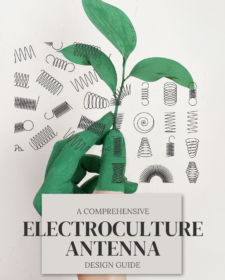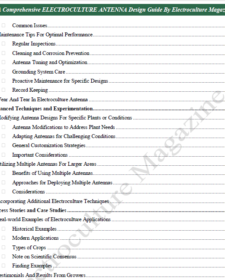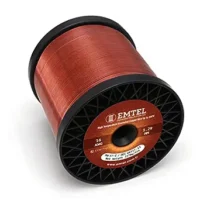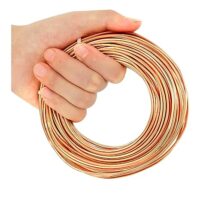Step into the world of Electroculture Magazine, where we unravel the fascinating realm of “Top 9 Ideas for Electroculture Antennas”. In this article, we delve into a myriad of innovative concepts that promise to revolutionize plant growth. Discover how electromagnetic fields hold the key to unlocking novel pathways for enhanced yields. Whether you’re a seasoned electroculture aficionado or a curious beginner, join us on this journey to explore captivating antenna ideas that nurture both creativity and practicality.
In this insightful post, we’re excited to unveil a treasure trove of innovative concepts that hold the promise of transforming the way we cultivate plants. The synergy between electromagnetic fields and plant growth is an uncharted territory that is redefining the boundaries of agricultural practices. Join us as we explore a diverse range of groundbreaking antenna ideas that not only pique curiosity but also offer practical solutions for optimizing plant growth and yield. Whether you’re an electroculture aficionado or a newcomer intrigued by the potential of electromagnetic marvels, this article is your guide to unlocking the secrets of these antennas and their remarkable impact on the world of agriculture.
Learn All About Anetnna Design, Buy Our Handcrafted Electroculture Anetnna Design eBook Now…
Basics
Electroculture antennas, ingenious devices designed to emit targeted electromagnetic fields, have emerged as pivotal tools in the pursuit of enhancing plant growth and maximizing agricultural productivity. The realm of electroculture encompasses the strategic application of precise frequencies, voltages, or currents to plants, orchestrating a symphony of physiological enhancements and growth optimization.
Diverse in form and function, electroculture antennas encompass an array of types such as loop antennas, helical antennas, dipole antennas, and microstrip antennas. Through the emission of electromagnetic waves, these antennas wield the power to intricately influence cellular activities, nutrient absorption mechanisms, and the overarching growth trajectories of plants.
At the core of electroculture antenna deployment lies the strategic objective of establishing a meticulously controlled electromagnetic milieu. This environment, carefully curated, fosters robust and resilient plant growth, ultimately yielding a bounty of benefits. From elevated crop yields that promise bountiful harvests, to bolstered resistance against pestilence and disease, the application of electroculture antennas holds the potential to revolutionize modern agriculture. Additionally, the integration of these antennas could potentially reduce the reliance on conventional agricultural inputs like pesticides and fertilizers, paving the way for more sustainable practices.
Harnessing the capabilities of electroculture antennas, farmers and horticulturists find themselves on the frontier of innovation. Armed with these antennas, they gain the power to experiment with an array of electromagnetic frequencies, refining and personalizing their cultivation methods. This exploration not only fosters novel insights but also contributes to the evolution of agricultural practices that are both ecologically sound and technologically progressive. As we journey deeper into the world of electroculture antennas, we stand at the precipice of a new era in agriculture—one characterized by amplified growth, sustainable solutions, and boundless possibilities.
Top 9 ideas for Electroculture Antennas
- Waveform Modulator Antenna : This antenna features a waveform modulator that permits precise control and manipulation of the emitted electromagnetic waves. It permits the modification of waveforms, frequencies, and intensities to tailor the stimulation to the specific needs of the plant.
- Smart Grid Antenna Network : The implementation of a network of interconnected antennas strategically distributed throughout the cultivation area constitutes a smart grid antenna network. This system combines sensors, actuators, and sophisticated algorithms to optimize the electromagnetic field distribution based on real-time plant data, environmental conditions, and development stages.
- Pulsed Magnetic Field Array : This antenna design consists of a collection of smaller emitters of pulsed magnetic fields. By synchronizing the pulsing patterns, a dynamic electromagnetic field is generated that promotes plant cell growth and enhances nutrient absorption, resulting in enhanced plant health and yield.
- Frequency Spectrum Scanning Antenna : This antenna examines a broad range of electromagnetic spectrum frequencies. By observing plant responses to various frequencies, it is possible to identify optimal frequency ranges for particular cultivars or growth stages, thereby facilitating the development of customized electroculture treatments.
- Vertical Spiral Antenna Tower: This novel antenna design employs a tower structure with spiral antennas arranged vertically. The vertical orientation optimizes the coverage area and permits uniform electromagnetic field distribution in vertical farming systems and multi-tiered cultivation setups.
- Adaptive Biofeedback Antenna : This innovative antenna integrates biofeedback mechanisms that collect real-time physiological data, such as electrical signals or biochemical markers, from plants. The antenna then modifies the emitted electromagnetic field based on the plant’s response, creating a closed-loop system that dynamically adapts to the requirements of the plant.
- Solar-powered Electroculture Antenna: This type of antenna uses solar panels to collect energy from the sun. The energy is then used to power a small electric current that is passed through the antenna. This type of antenna is a great option for people who want to use electroculture without having to worry about connecting to the electrical grid.
- Wireless Electroculture Antenna: This type of antenna uses radio waves to transmit energy to the plants. The radio waves are generated by a small device that is placed near the plants. This type of antenna is a great option for people who want to use electroculture in areas where there is no access to electricity.
- Bioelectric Electroculture Antenna: This type of antenna uses the body’s own electrical field to power the antenna. The antenna is placed on the body, and the electrical current from the body is used to power the antenna. This type of antenna is a great option for people who want to use electroculture without having to worry about connecting to the electrical grid or using any type of external power source.
These brand new ideas aim to push the boundaries of electroculture antenna design and explore novel ways to optimize plant growth and crop productivity. Remember, implementing such ideas may require further research, experimentation, and expert consultation to ensure their effectiveness and safety in practical applications.
Check Out This Some Best Antennas and tools for Your Electroculture Experiments...
Here are some additional tips for building and using an electroculture antenna:
- When choosing materials, it is important to use high-quality materials that will not corrode or degrade over time. Copper is a good choice for most antennas, but other materials such as stainless steel and aluminum can also be used.
- When placing the antenna, it is important to place it in a location where it will not be disturbed by foot traffic or other activities. The antenna should also be placed in a location where it will not be exposed to direct sunlight or moisture.
- When using the antenna, it is important to monitor the plants to see how they are responding. If the plants are not responding well, it may be necessary to adjust the settings on the antenna or move it to a different location.
How to Choose Right Antenna for Electroculture ?
When choosing the right antenna for electroculture, there are several factors to consider. Here are some key considerations to help you make an informed decision:
- Plant Requirements: Different plant species and growth stages may react differently to particular electromagnetic frequencies and field intensities. Investigate the specific electroculture needs of the vegetation of interest. Some plants may flourish with a broad-spectrum antenna, whereas others may prosper with a narrower frequency range or a specific waveform.
- Targeted Area: Consider the size and configuration of the area you wish to cover with the electromagnetic field. The design and placement of antennas should guarantee uniform coverage and optimal field distribution across the entire intended cultivation area. Evaluate whether a single antenna or a network of antennas would serve your application better.
- Type of Antenna: Evaluate the benefits and drawbacks of different antenna varieties, such as loop antennas, helical antennas, dipole antennas, and microstrip antennas. Each sort possesses a distinct radiation pattern, gain, and operating characteristics. Choose an antenna layout that corresponds to your electroculture objectives, available space, and technical specifications.
- Frequency Range: Determine the frequency range that corresponds to your electroculture objectives. Some antennas can cover a wide frequency range, whereas others are designed for specific frequency bands. Ensure that the antenna you select can effectively emit the frequencies required for stimulating plant growth.
- Power and Control: Evaluate the antenna’s power requirements and control mechanisms. Depending on your configuration, you may need to ensure that the antenna is compatible with the available power supply and can be readily controlled and adjusted for modulation of frequency, waveform, and intensity.
- Expert Recommendation: Seek guidance from electroculture-experienced experts or consultants. They can provide valuable insight, recommend suitable antenna options based on your unique requirements, and assist you in optimizing your electroculture configuration for maximum efficiency.
It’s important to note that electroculture is an emerging field, and the effectiveness of different antenna designs may vary depending on numerous factors. Consider conducting small-scale experiments or pilot studies to evaluate the performance of different antennas before implementing them on a larger scale.
Final Words
As we bring our exploration of the top 9 ideas for electroculture antennas to a close, it’s evident that these remarkable devices hold the potential to reshape the future of agriculture. The convergence of electromagnetic innovation and plant cultivation has unveiled a realm of possibilities that can revolutionize how we nourish our planet.
In this journey, we’ve uncovered the diverse spectrum of electroculture antennas, from the elegance of loop antennas to the intricacy of helical designs and beyond. These antennas don’t just emit electromagnetic fields; they emit hope for more sustainable and productive agricultural practices.
The promise of optimized plant growth, increased crop yields, and heightened disease resistance stands as a beacon of hope in an increasingly complex agricultural landscape. By integrating electroculture antennas into cultivation methodologies, we may reduce the environmental impact of conventional farming practices while simultaneously enhancing food security.
As we venture into this new era, let curiosity be our guide and innovation our compass. Let’s embrace these antenna ideas not just as concepts, but as catalysts for change in the way we interact with nature. Through ongoing research, experimentation, and collaboration, we can unlock the full potential of electroculture antennas and cultivate a greener, more abundant tomorrow.
Thank you for accompanying us on this illuminating journey through the world of electroculture antennas. The path ahead is electrifying, and together, we have the power to cultivate a thriving future for our planet and generations to come.
Check Out This Some Best Copper Wire for Your Electroculture Antennas..

























